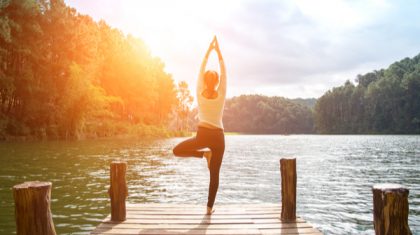According to the WHO 2014 survey, there are over 422 million diabetics worldwide. With increasing unhealthy lifestyle choices, predictions have been made that by 2030, diabetes will occupy the seventh spot as the cause of death. However, a few amendments to your lifestyle can help you manage or even control your diabetes. Read this article to know the benefits of yoga for diabetics.

Yoga not only improves insulin production but also helps in decreasing the chances of low blood sugar levels. Moreover, it also reduces the production of bad cholesterol and triglyceride levels in the body. The benefits of yoga are not just limited to physical health. It can even help people with diabetes by calming the mind and integrating it with the body.
Start your Type 2 Diabetes Reversal.
Tracing the Benefits of Yoga for Diabetes
Yoga tends to fill in the gaps and correct minor defects in the pathway to make your system healthier and stronger. Each postulate corrects every flaw in our day-to-day lives, leaving us with a healthier body. But of course, one must choose the poses carefully.
Boost metabolism, burn fat and promote gut health with Kapiva Get Slim Juice
Yoga for Diabetics: Try These 6 Poses
The yoga asanas that proved beneficial are listed below-
1. Dhanurasana
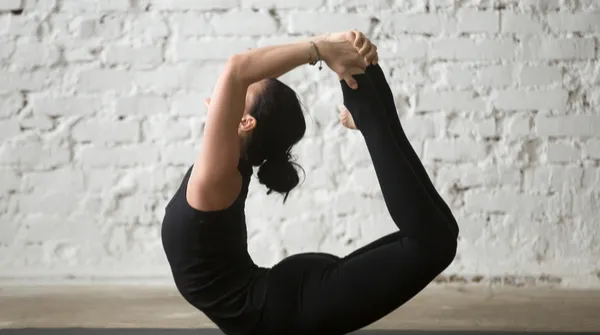
Also known as bow pose or Urdva Chakrasana, this asana strengthens the back, relieves menstrual pains and other discomforts
Instructions:
- Lie flat on your stomach.
- Fold your knees to stretch your hands on either side and hold your ankle.
- As you breathe in the fresh air, lift your chest off the ground.
- Watch your breath as you look straight. Retain the pose for no longer than fifteen to twenty seconds.
- As you exhale, bring your chest back to the ground and let go of your ankles gently.
This asana improves digestion by relieving flatulence and constipation. It has magical effects on the liver, intestines, and pancreas and is thus beneficial for people with diabetes.
2. Ardhamatsayendrasana
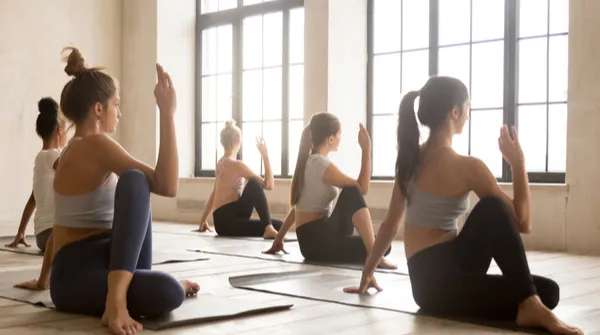
Ardhamatsyasana or vakrasana is also called half spinal twist and half lord of the fishes. However, the twist in the abdomen is not suitable for menstruating or pregnant women.
Instructions:
- Kneel down and sit on your heels with your back straight.
- Move your legs to the right as you inhale.
- Rest your hands firmly on the ground for support.
- Place your left leg over your right leg.
- Bring your right heel closer to your buttocks and the left foot closer to your right thigh for support.
- Stretch your arms and twist your upper body to the left side. Rest your hands on the ground for support.
- Slowly, exhale and untwist your upper body after stretching your arms.
- Move your left leg so as to bring it to the position your left leg is inside.
- Come back to your original position, where you kneel down with your buttocks resting on your heels.
- Repeat the exercise with your right leg.
People with diabetes find it difficult to digest food. It is retained in the intestines, increasing the chances of tumors and the putrefaction of food often leads to colon cancer. Ardhamatsyasana cleans the intestines and stimulates the secretion of pancreatic juices, which cater to various physiological activities in the body, including digestion, and aid in both phases of the detoxification process in the liver.
3. Bhujangasana
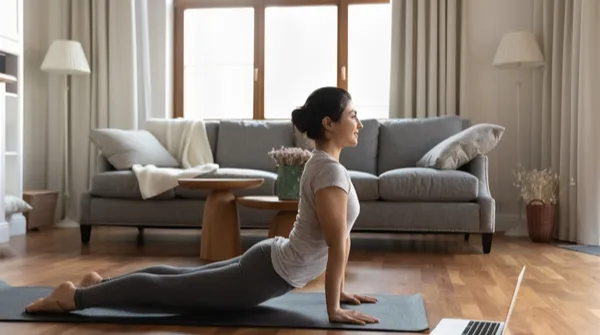
Bhujangasana is frequently addressed as the cobra pose. Good for thyroid, slipped disc, and alleviating rheumatism, bhujangasana is not recommended for hypothyroid patients.
Instructions:
- Lie down flat on your stomach.
- Bring your legs together. However, leave a gap of a foot or two when practiced to cure backache.
- Bend your hands at your elbows and rest them beside the shoulder.
- Slowly inhale as you lift your chest off the ground.
- Look straight as your muscles relax.
- Slowly exhale the air and bring your chest back to the ground.
- Keeping your legs together, lie flat on your stomach for a minute before you can resume the pose.
Awaking kundalini, the primal energy at the base of the spine, directly influences neurons and essential nerves. It strengthens the spine and releases tension and stress from the back muscles. By compressing the kidneys, it allows the Bowman’s capsule to effectively filter stagnated blood and flush the toxins out of the body. Practicing bhujangasana alongside a diet rich in avocados and walnuts stimulates the secretion of glutathione. This effective compound helps flush toxins out of the body.
4. Naukasana
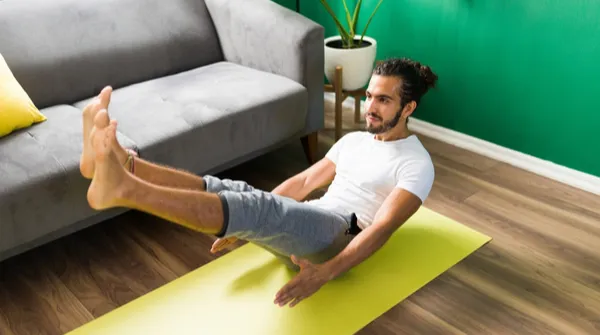
Naukasana, as the name suggests, causes the body to take the shape of a ‘nauka’, or a boat. It has special significance in Padma Sadhana, where it is practiced after Dhanurasana. This pose is a big no-no if you suffer from migraine, frequent headaches, asthma, and cardiovascular ailments.
Instructions:
- Lie on your back.
- Rest your hands beside your body, and your legs close together.
- Look straight as the idea is to keep your eyes, nose, and toes in a line.
- Slowly lift both your feet and your shoulders off the ground simultaneously.
- As the tension in your abdomen builds up, feel the muscles contract gently.
- Retain the position for twenty seconds and increase the timespan with practice.
- Exhale gently and bring both your shoulders and your feet back on the ground.
Again, working on the abdominal area, naukasana slims down the limbs and the fat deposition in the navel region. Exposing lungs, liver, and pancreas to optimum pressure, it allows faster digestion, effective absorption, and assimilation of the nutrients. Applying pressure on the intestines and the rectum alleviates constipation with regular riddance from the solid wastes in the body.
5. Halasana
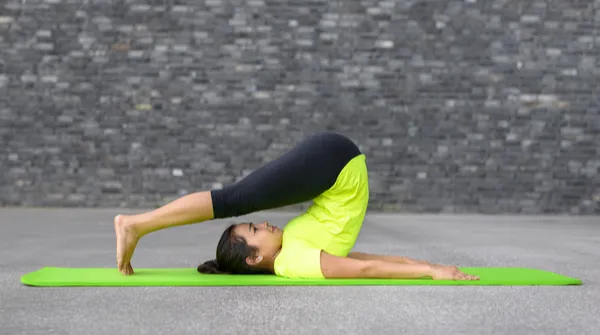
Halasana or the plow pose is therapeutic for the muscles as they stretch and relax to release stress. Since it lays considerable pressure on the cervical region or the neck, it must be practiced with caution. It also prepares the mind for rejuvenation and an influx of positivity.
Instructions:
- Lie flat on your back with your arms resting on either side of your body.
- Inhale and raise your feet above the floor to form a ninety-degree angle with the floor.
- Supporting your hips and waist with the help of your hands, slowly lift it from the ground.
- Let your legs sweep as it experiences a hundred and eighty-degree rotation to rest the toes firmly on the ground.
- Rest your hands on either side of the body and retain the posture for forty-five seconds.
- Exhale and support your hips and waist to bring your legs in the air forming a ninety-degree angle with the floor.
- Without letting go of the support, bring your legs back to the position where you lay flat on your back on the ground.
Besides releasing stress and fatigue, halasana effectively regulates blood sugar levels by improving digestion. It also removes gas and back pains.
6. Vajrasana
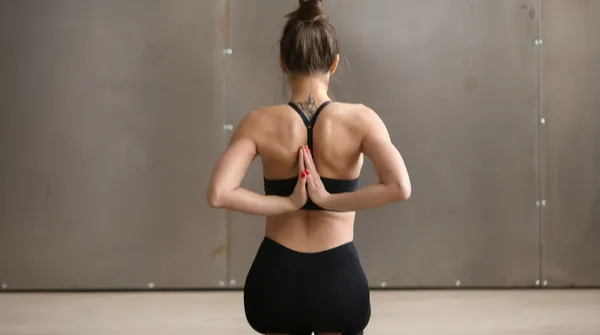
Vajrasana or diamond pose is a simple sitting asana. It can be practiced at any time of the day. This asana is often used for practicing various other asanas and meditation. Regular practice of this asana makes the body healthier and stronger.
Instructions:
- Kneel down on your knees.
- Make sure that the toes of both feet are touching.
- Rest your buttocks on the heels.
- Rest your hands on either knee with the palm facing the sky.
- Inhale and exhale as you retain the pose for a good two minutes.
- Slowly increase the time interval for holding the position.
Working on the core strength of the body, the abdomen, and the legs, this asana helps in reducing the hip fat, predominantly present in most women post-pregnancy or while approaching menopause. Vajrasana cures acidity. It lays pressure on the kidney to filter urea effectively. Increasing circulation, this asana also relieves knee pain, yet another common effect of obesity and diabetes.
Read More: Practise These 5 Exercises for Diabetes At Home
Try out these asanas even if they seem difficult at first. They can do wonders in managing your blood sugar levels. Embrace some discipline and, as they say, “take care of the little things and the rest will fall in place.”
To track the improvements in your blood sugar levels, get yourself a compact glucometer. Moreover, download the BeatO App to learn more about such ways to manage your glucose levels.
Author: Shahana Khatoon

